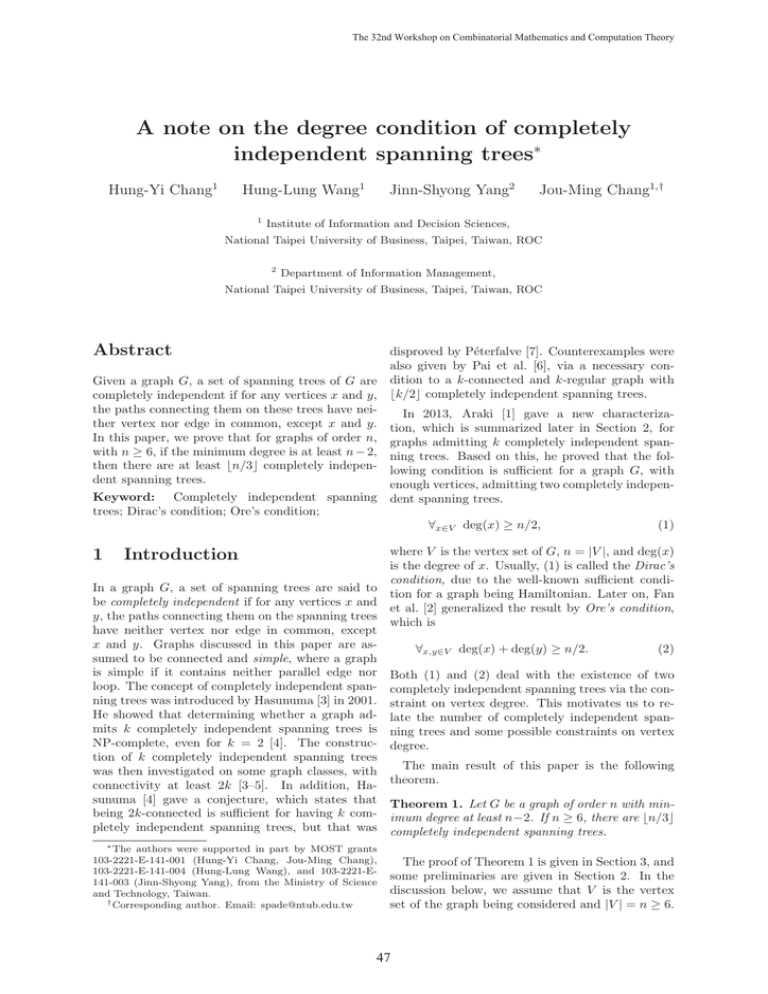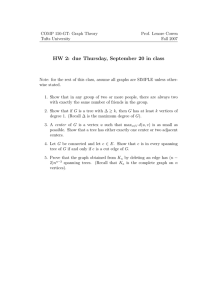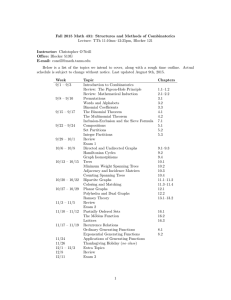A note on the degree condition of completely independent spanning
advertisement

The 32nd Workshop on Combinatorial Mathematics and Computation Theory
A note on the degree condition of completely
independent spanning trees∗
Hung-Lung Wang1
Hung-Yi Chang1
1
Jinn-Shyong Yang2
Jou-Ming Chang1,†
Institute of Information and Decision Sciences,
National Taipei University of Business, Taipei, Taiwan, ROC
2
Department of Information Management,
National Taipei University of Business, Taipei, Taiwan, ROC
Abstract
Given a graph G, a set of spanning trees of G are
completely independent if for any vertices x and y,
the paths connecting them on these trees have neither vertex nor edge in common, except x and y.
In this paper, we prove that for graphs of order n,
with n ≥ 6, if the minimum degree is at least n − 2,
then there are at least n/3 completely independent spanning trees.
disproved by Péterfalve [7]. Counterexamples were
also given by Pai et al. [6], via a necessary condition to a k-connected and k-regular graph with
k/2 completely independent spanning trees.
In 2013, Araki [1] gave a new characterization, which is summarized later in Section 2, for
graphs admitting k completely independent spanning trees. Based on this, he proved that the following condition is sufficient for a graph G, with
enough vertices, admitting two completely indepenKeyword: Completely independent spanning dent spanning trees.
trees; Dirac’s condition; Ore’s condition;
∀x∈V deg(x) ≥ n/2,
(1)
where V is the vertex set of G, n = |V |, and deg(x)
is the degree of x. Usually, (1) is called the Dirac’s
condition, due to the well-known sufficient condiIn a graph G, a set of spanning trees are said to
tion for a graph being Hamiltonian. Later on, Fan
be completely independent if for any vertices x and
et al. [2] generalized the result by Ore’s condition,
y, the paths connecting them on the spanning trees
which is
have neither vertex nor edge in common, except
x and y. Graphs discussed in this paper are as∀x,y∈V deg(x) + deg(y) ≥ n/2.
(2)
sumed to be connected and simple, where a graph
is simple if it contains neither parallel edge nor Both (1) and (2) deal with the existence of two
loop. The concept of completely independent span- completely independent spanning trees via the conning trees was introduced by Hasunuma [3] in 2001. straint on vertex degree. This motivates us to reHe showed that determining whether a graph ad- late the number of completely independent spanmits k completely independent spanning trees is ning trees and some possible constraints on vertex
NP-complete, even for k = 2 [4]. The construc- degree.
tion of k completely independent spanning trees
The main result of this paper is the following
was then investigated on some graph classes, with
theorem.
connectivity at least 2k [3–5]. In addition, Hasunuma [4] gave a conjecture, which states that Theorem 1. Let G be a graph of order n with minbeing 2k-connected is sufficient for having k com- imum degree at least n−2. If n ≥ 6, there are n/3
pletely independent spanning trees, but that was completely independent spanning trees.
1
Introduction
∗ The authors were supported in part by MOST grants
103-2221-E-141-001 (Hung-Yi Chang, Jou-Ming Chang),
103-2221-E-141-004 (Hung-Lung Wang), and 103-2221-E141-003 (Jinn-Shyong Yang), from the Ministry of Science
and Technology, Taiwan.
† Corresponding author. Email: spade@ntub.edu.tw
The proof of Theorem 1 is given in Section 3, and
some preliminaries are given in Section 2. In the
discussion below, we assume that V is the vertex
set of the graph being considered and |V | = n ≥ 6.
47
The 32nd Workshop on Combinatorial Mathematics and Computation Theory
2
Preliminaries
Proof. Let n = 2k, for k ≥ 1. We prove this lemma
by induction on k. For k = 1 the lemma holds
In a graph G, the minimum degree δ(G) of G is trivially. Consider the case where k > 1. Since
defined as min{ deg(x) | x ∈ V }. A vertex x is G1 is (2k − 2)-regular, there are two vertices x1
said to be universal if deg(x) = n − 1. The open and x2 which are not adjacent. It follows immeneighborhood of a vertex x consists of all the ver- diately that N (x1 ) = N (x2 ), and G1 [N (x1 )] is a
tices adjacent to x, denoted by N (x). We use Pi (2k − 4)-regular graph. Similarly, for G2 , there
and Ci to denote a path and a cycle with i vertices, are two non-adjacent vertices y1 and y2 such that
respectively. For U ⊆ V , the subgraph induced by G2 [N (y1 )] is (2k − 4)-regular. By the induction
U is denoted by G[U ]. For x ∈ V , we denoted the hypothesis, G1 [N (x1 )] and G2 [N (y1 )] are isomorsubgraph induced by V \ {x} by G − x, and anal- phic, and let f : V (G1 [N (x1 )]) → V (G2 [N (y1 )])
ogously, we use G − U for G[V \ U ]. For an edge be an isomorphism. It can be easily derived that
with end vertices x and y, we denote it by xy, and G1 and G2 are isomorphic via the isomorphism
the graph obtained by removing xy is denoted by f : V (G1 ) → V (G2 ), defined as
⎧
G − xy. Let E be the edge set of G. For disjoint
⎪
if v = x1 ,
⎨ y1
subsets U1 , U2 ⊆ V , the graph B(U1 , U2 ) is defined
f (v) = y2
if v = x2 ,
to be a bipartite graph with partite sets U1 and U2 ,
⎪
⎩
f (v) otherwise.
and edge set { xy ∈ E | x ∈ U1 , y ∈ U2 }. Araki [1]
gave the following characterization for a graph ad
mitting k completely independent spanning trees. This proves the lemma.
Theorem 2 (See [1]). A graph G has k completely Lemma 2. Let n be a positive even integer, and
independent spanning trees if and only if there is a let G be a simple graph with δ(G) ≥ n − 2. There
partition of V into V1 , V2 , . . . , Vk such that
exists an (n − 2)-regular spanning subgraph of G.
• for i ∈ { 1, 2, . . . , k }, G[Vi ] is connected.
• for distinct i, j ∈ { 1, 2, . . . , k }, B(Vi , Vj ) has
no tree component.
The partition is called a CIST-partition of G.
Proof. Since δ(G) ≥ n − 2, we may assume that
there are i vertices with degree n − 1 and n − i
vertices with degree n − 2, where 0 ≤ i ≤ n. Considering the sum of vertex degrees of G, we have
deg(v) = i(n−1)+(n−i)(n−2) = n(n−2)+i,
v∈V (G)
which leads to the fact that i is even. For i = 0,
there are at least two adjacent vertices which are of
degree n − 1. By iteratively removing these edges,
To simply the presentation, we elaborate the results we have an (n − 2)-regular subgraph.
for even n and odd n, separately, in Sections 3.1
and 3.2. The proofs for both cases are very similar.
Remark 1. If n is even, the (n − 2)-regular graph
can be obtained by removing a perfect matching
from Kn .
3.1 For even n
3
Main results
The idea for proving Theorem 1 for a graph G of
even order is to show the following.
Remark 2. Graphs with minimum degree k do not
always contain a k-regular subgraph, even for k =
n − 3.
• There is an (n − 2)-regular spanning subgraph
of G.
Lemma 3. Let G be an (n − 2)-regular graph. If
n ≥ 6, then there are n/3 completely independent
spanning trees.
• All (n − 2)-regular graphs are isomorphic.
• There are n/3 completely independent spanning trees in an (n − 2)-regular graph.
Details are given in Lemmas 1, 2, and 3.
Lemma 1. Let G1 and G2 be simple graphs of order n, where n is even. If G1 and G2 are (n − 2)regular, then G1 and G2 are isomorphic.
Proof. By Theorem 2, it suffices to show that there
is a size n/3 CIST-partition. Let k = n/3, and
let V be partitioned into V1 , V2 , . . . , Vk as even as
possible, i.e.,
∀i∈{1,...,k} 3 ≤ |Vi | ≤ 4.
Without loss of generality, let j be the index such
that |Vi | = 3 for 1 ≤ i ≤ j, and |Vi | = 4 for i > j.
48
The 32nd Workshop on Combinatorial Mathematics and Computation Theory
V3
Vj−1
...
V2
V4
Vj+1
...
V1
Vj
Vk
Figure 1: The CIST-partition of G defined in Lemma 3. The vertices are pairwise adjacent, except those
connected by dotted lines. In other words, dotted lines denoted the perfect matching removed from Kn .
Notice that when j = 0, there is no Vi of size 3.
Similar to Lemma 3, we can show the existence
Clearly, j is even, and we can further define the of n/3 completely independent spanning trees of
partition so that
G by defining a CIST-partition of size n/3. The
partition is similar to that defined in Lemma 3. The
only modification we need is to deal with the odd
• G[Vi ] is P3 , for 1 ≤ i ≤ j.
number of subsets of size three. By letting the
universal vertex be in one of these subsets, we get
the requested CIST-partition. More precisely, let x
be the universal vertex, and let yz be a non-edge.
The graph G − {x, y, z} is of order n − 3 and is
• G[Vi ] is C4 , for i > j.
(n − 5)-regular. We can partition the vertices of
G − {x, y, z} as we do in Lemma 3. Together with
An illustration is given in Figure 1. By definition,
the subset {x, y, z}, we have the CIST-partition of
Vi induces either P3 or C4 on G. Moreover, for any
G. This yields the following theorem.
two subsets Vl and Vr , B(Vl , Vr ) is either K3,3 − e
or a complete bipartite graph other than a star. It Lemma 6. Let G be an (n−2)+ -regular graph with
follows that V1 , V2 , . . . , Vk is a CIST-partition of G. order n. If n ≥ 6, then there are n/3 completely
This proves the lemma.
independent spanning trees in G.
• G[V2i−1 ∪ V2i ] is a 4-regular graph, for 1 ≤ i ≤
j/2.
3.3
3.2
Proof of Theorem 1
For odd n
Proof. Consider the case where n is even. By Lemmas 1 and 2, it suffices to show that “the” (n − 2)For odd n, any graph G with minimum degree at
regular graph contains n/3 CISTs, and the result
least
n−2 cannot be (n−2)-regular since otherwise is given by Lemma 3. Similarly, for n being odd,
v deg(v), which is n(n − 2), is odd. Thus, at least
the result can be derived from Lemmas 4, 5 and 6.
one vertex x of G has degree n − 1. Consider the
Thus, Theorem 1 is proved.
graph G − x. Obviously, G − x is a graph on which
lemmas in Section 3.1 hold. Therefore, the “odd
n version” of Lemmas 1 and 2 can be derived in
a straightforward manner. We elaborate in more 4
Concluding remarks
detail as follows.
For convenience, we define a graph G to be k + regular if
• there is exactly one vertex x with deg(x) =
k + 1, and
In this paper, we show that for a graph G of order
n ≥ 6 with δ(G) ≥ n − 2, there are n/3 completely independent spanning trees. As mentioned
in Section 1, the following results are known:
• for each vertex y other than x, deg(y) = k.
Lemma 4. Let G1 and G2 be simple graphs of order n, where n is odd. If G1 and G2 are (n − 2)+ regular, then G1 and G2 are isomorphic.
• If δ(G) ≥ n−1, there are (n−1)/2 completely
independent spanning trees [6].
• If δ(G) ≥ n/2, there are 2 completely independent spanning trees [1].
A straightforward generalization of the above two
statements is “If δ(G) ≥ a, there are b completely
Lemma 5. Let n be a positive odd integer, and let independent spanning trees.” How a and b are reG be a simple graph with δ(G) ≥ n−2. There exists lated is what we are interested in, and this problem
will be conducted as future work.
an (n − 2)+ -regular spanning subgraph of G.
49
The 32nd Workshop on Combinatorial Mathematics and Computation Theory
References
[1] T. Araki, Dirac’s condition for completely independent spanning trees, J. Graph Theor. 77
(2014), 171–179.
[2] G. Fan, Y. Hong, Q. Liu, Ore’s condition for
completely independent spanning trees, Discrete Appl. Math. 177 (2014), 95–100.
[3] T. Hasunuma, Completely independent spanning trees in the underlying graph of a line
graph. Discrete Math. 234 (2001), 149–157.
[4] T. Hasunuma, Completely independent spanning trees in maximal planar graphs, Proceedings of 28th Graph Theoretic Concepts
of Computer Science (WG2002), LNCS 2573,
235–245.
50
[5] T. Hasunuma, C. Morisaka, Completely independent spanning trees in torus networks, Networks 60 (2012), 60–69.
[6] K.-J. Pai, S.-M. Tang, J.-M. Chang, and J.-S.
Yang, Completely independent spanning trees
on complete graphs, complete bipartite graphs
and complete tripartite graphs, IEICE Trans.
Inf. Syst. 20 (2013), 107–113.
[7] F. Péterfalvi, Two counterexamples on completely independent spanning trees, Discrete
Math. 312 (2012), 808–810.




